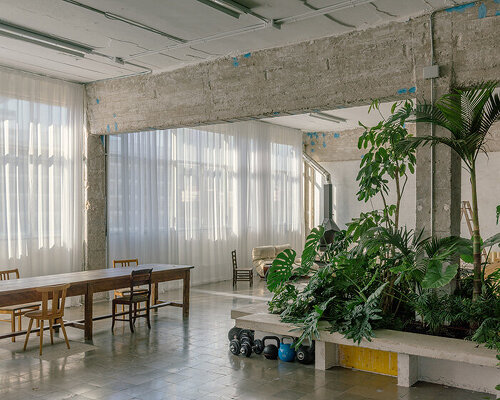Atienza Maure renovates printing warehouse near barcelona
Atienza Maure transforms a 450-square-meter printing warehouse into La Nave, a hybrid environment that combines work and home in the post-industrial fringe of Sant Adrià de Besòs, Spain, just outside Barcelona. The project houses both the headquarters of a tech company and the personal residence of one of its founders. Developed on a shoestring budget, the architects achieve spatial richness through the inventive reuse of low-cost industrial systems, reminiscent more of server racks and shelving than conventional construction, resulting in a labyrinthine landscape of metal and plywood.
all images by Simone Marcolin
La Nave hosts living and working in flexible industrial shell
The warehouse, tucked inside a mixed-use block still bearing traces of its industrial past, sits among carpentry workshops, storage depots, independent churches, and even a spa. With no access to new openings or skylights, the Barcelona-based team at Atienza Maure opted for a radically open floor plan, introducing a series of mobile and double-access volumes that act as programmatic buffers between work and life. These units, accessible from two separate points, are designed to be claimed by either zone as needed.
Circulating through La Nave feels more like drifting through a game level than walking through a building. A network of raised platforms, switchback staircases, and intersecting routes offers multiple ways to move through the space. This non-hierarchical layout, with no central corridor or dominant axis, encourages movement guided by use, habit, or convenience. This open and layered approach allows the residential and work areas to overlap without needing clear separations.
Atienza Maure transforms a 450-square-meter printing warehouse
white concrete elements anchor the fluid layout
To meet a strict budget of under €380 per square meter, the architects relied on low-cost, prefabricated components typically used in industrial settings. The main structure is made from galvanized steel L-profile shelving, a system more often associated with storage than construction. These elements support metal trays and threaded rods, which function both as walkable surfaces and as areas for storage. Plywood is used for floors and wall enclosures, while translucent polycarbonate panels provide internal openings that let in daylight without compromising privacy between zones.
This systematized construction approach is balanced by a few more fixed elements, most notably, built-in pieces made from white concrete. These points introduce a sense of weight and stability within an otherwise flexible framework.
a hybrid environment that combines work and home
a network of raised platforms, switchback staircases, and intersecting routes offers multiple ways to move
the project houses both the headquarters of a tech company and the personal residence of one of its founders
the architects achieve spatial richness through the inventive reuse of low-cost industrial systems
a labyrinthine landscape of metal and plywood
this open and layered approach allows the residential and work areas to overlap
the architects relied on low-cost, prefabricated components
translucent polycarbonate panels provide internal openings
introducing a series of mobile and double-access volumes
letting in daylight without compromising privacy
the main structure is made from galvanized steel L-profile shelving
project info:
name: La Nave
architects: Atienza Maure Arquitectos | @atienzamaure
location: Sant Adrià de Besòs, Barcelona, Spain
area: 450 square meters
photographer: Simone Marcolin | @simoneemarcolin
The post atienza maure converts barcelona warehouse into live-work space using industrial systems appeared first on designboom | architecture & design magazine.

